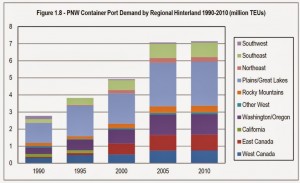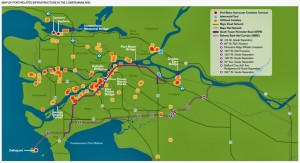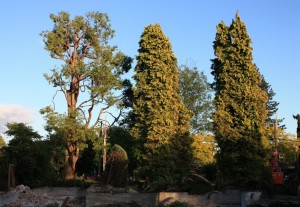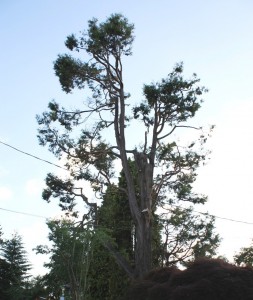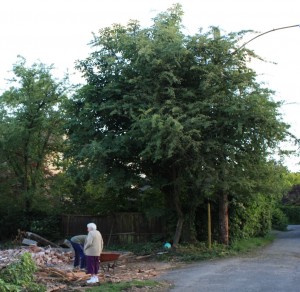So much complaining and winging on this blog recently, I’m glad to talk about a good news story for a change!
I’m bully about the future of District Energy Utilities, and so it is good to hear New Westminster is starting to explore the prospect more seriously. The location in lower Sapperton provides an interesting collection of geographic opportunities that might make for a very successful system. But before the details, let’s do a quick primer on District Energy Utilities.
Like any other utility, a DEU is one where a single entity supplies the source and distribution system of a vital commodity, usually as a monopoly, and therefore covered by the BC Utilities Act. That Act assures the public can benefit from the inherent efficiency of a single supplier and integrated supply network, but that the consumer does not get gouged by the lack of competition. When you think of our drinking water supply or electricity grid, it is hard to imagine how else it could be managed. When it comes to “energy”, the concept is a little less clear.
An energy utility produces heat energy (usually through a boiler or heat exchanger), and distributes it (usually in the form of hot water or steam) to a selection of customers. For a variety of reasons, efficiencies can be found in producing the energy in a central site and distributing it widely, instead of having a small boiler in every building. This efficiency can be enhanced by building a larger-scale high efficiency system, and the sustainability of the entire utility improved by choosing a sustainable energy source.
Think about your typical apartment building. New ones generally have electric baseboard heaters around the periphery of glass-walled suites. This relies on the inherent efficiency of the province-wide BC Hydro electrical grid to be affordable, but at the local level, it is not in the least bit efficient. Older buildings are more likely to have boilers in the basement that burn natural gas and heat water which in turn circulates through the building to warm the rooms. The efficiency of this type of system relies on the efficiency of the boiler and the engineering of the distribution network in the building.
A DEU is like the second example. A single water-heating facility, and a system of pipes that moves hot water to the customer buildings. In each of those buildings, a high-efficiency heat pump turns the DEU-heated water into intra-building heated water, and distributes the warmth through the building. In theory, this entire system can also be designed to take heat out of the building in the summer, like any other heat pump.
There are several examples of DEUs operating in the lower mainland, and I have toured two of them. The first, and most famous, is the Southeast False Creek DEU. This is fast becoming the model of a “medium temperature” district energy system whose main energy source is the heat of sewage water.
 |
| Diagram from City of Vancouver website. |
There happens to be a big sanitary sewer line than runs by the site, and due to the fact we heat much of the water we use before we dispose of it, and there is so much …uh…organic activity in our sewage, it tends to be warm. There is so much warm sewage in this line that stripping off a few degrees of heat (the temperature exchanger reduces the sewage temperature by less than 5 degrees centigrade) results in a huge amount of energy to run the heat pump. There is enough energy that the system provides the vast majority of the heating and hot water for the buildings being built around the utility. The utility also has an efficient gas-fired boiler to “boost” the energy demand for those few days a year when Vancouver gets really cold and an exceptional amount of energy is needed. At full build-out, the sewage heat will supply about 70% of the total energy needs of the community.
The second example I have toured recently is in the Alexandria neighbourhood of Richmond. This is a very different system, although the fundamental idea is the same. The difference is that this is a “low temperature” system that relies on geothermal energy source. This energy source is a field of 250-foot deep metal loops with a coolant running through them.
 |
| Image from City of Richmond website. |
As groundwater a couple of hundred feet down is always around 12 degrees centigrade, the temperature between this temperature and heating season ambient temperatures is small (hence “low temperature”) but it still produces a surprising amount of energy. The system is also scaleable, and as the surrounding neighbourhood is built up and more energy is required, the system can be easily scaled up, using pretty much any energy source, from more geothermal to solar water heating to sewer heat (as the local waste water volume ramps up with development).
 |
| When I toured the Alexandra energy centre, it still had that New Utility Smell. |
These systems provide significant benefits for users (as energy prices become more stable – not linked to volatile gas or electricity markets), for the environment (replacing fossil fuels and inefficient baseboards with a highly efficient heating system), and for the City that builds them (once the capital costs are paid off- about 10-20 years depending on the system, these utility systems should be a revenue source for the operator).
Back here in New Westminster, it appears from the report to Council, the proposed DEU will be a “medium temperature” variety, not unlike the Southeast False Creek system. This makes sense with the intensity of energy use from a relatively compact footprint. There is also the proposal to use waste heat from a major trunk sanitary sewer that happens to run right by the spot. Clearly, there are details to work out, but we are not inventing a wheel here, we are potentially benefiting from a system that is already successfully operating in hundreds of places, and has already proven itself to be financially sound and energy efficient.
The other option floated is to use a gasification plant to burn waste wood, which is the system that powers Victoria’s groundbreaking Dockside Green development, and also happens to be the system that the Kruger paper plant in New Westminster uses to produce power and steam, significantly reducing their greenhouse gas production by reducing the need to burn gas. I cannot emphasise enough this system is very different that a trash incinerator like the one in Burnaby. First off, the emissions from a gasification plant are remarkably low (and easily cleaned), and secondly, the waste wood represents biospheric carbon, not fossil carbon, so it does not increase the net greenhouse gas budget of the planet.
Actually, since both of these heat sources can be used on the same system, as they both represent “medium temperature” energy sources, and there is not reason (except maybe the economics of scale efficiencies) that the City cannot build both systems, in a staged approach as the Hospital expansion, the final pieces in the Brewery District, and other developments in the area take place.
So this is first steps, but it is good to hear the City is taking this idea seriously.



